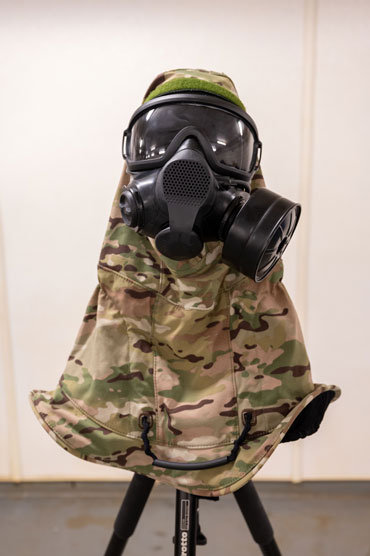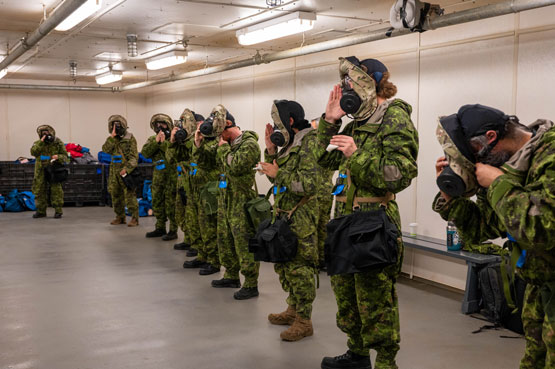March 1, 2024
Shaved skin used to be the only way to get a good seal and adequate respiratory protection wearing a gas mask, but research trials on a new respirator, called the C5B, promise a “breath of fresh air” during training drills for Canadian Armed Forces (CAF) members who have beards, long hair, headdresses or uniquely shaped faces.
CAF members train to use a chemical, biological, radiological, nuclear (CBRN) respirator in a gas hut during basic military qualifications and regularly renew this training throughout their careers. For CAF members with beards, long hair, headdresses or uniquely shaped faces, who were not able to achieve a good seal on their respirator, this training regularly included stinging eyes and runny noses from the tear gas, used to test their skills in the gas hut.

The C5B is a hood accessory for the C5 respirator that provides respiratory protection by forming a clean air chamber around the entire head. Credit: Michael Franz / Defence Research and Development Canada
“I used to always dread going into the gas hut because I was going to breathe in the tear gas and it was going to be a horrible experience,” says Cpl Ouiam Meftah, who has participated in four research trials on the new respirator. “Now to have a respirator that actually fits my face and I can breathe and know that I’m safe and that I’m not going to be breathing in any chemicals, it feels great. I’m actually excited to do the gas hut because I know it is going to be a fun experience.”
Defence Research and Development Canada (DRDC) worked with the Canadian Army’s directorate of joint CBRN defence (J CBRN), an industry partner, AirBoss Defense, and the Royal Military College of Canada, to develop and test the new respirator.
“New recruits who have beards, long hair, uniquely shaped faces, or headdresses for reasons of faith, can go into the gas hut and complete their training without smelling or feeling the effects of the tear gas,” says Dr. Paul Bodurtha, the lead scientist on this project at DRDC. “They can participate in training and perform the same drills like their cohorts and feel included as part of the military.”
How it works
The C5B is a hood-style accessory to the C5 respirator. A CAF member places the respirator against their face, pulls the hood back over their head, and then tucks the hood edges into their CBRN protective suit.
“The new concept is a clean chamber around your head,” explains Maj Christian Doucet, with J CBRN. The hood is tightened snug against the head and neck, helping to keep the chamber clean of tear gas. The fabric also has an aerosol filtration membrane similar to an N95 mask further providing an extra layer of protection.
The result is sufficient respiratory protection to complete the same training drills as members wearing other in-service respirator such as the C4 or C5, without tear gas getting in their eyes or nose.
“We have heard feedback from people who went into the gas hut and did not smell any tear gas, for the first time in up to 30 years with the Canadian Armed Forces,” says Maj Doucet.

Trial participants practice a drill to properly don a C5B respirator at the CFB Esquimalt Damage Control School in November 2023. Credit: Michael Franz / Defence Research and Development Canada
Having the option of the C5B during training isn’t just about religious accommodation. CAF members may also choose to train with it because of fit issues with other respirators, or to practice with a respirator that will work when they haven’t shaved.
The final user trial of the new respirator took place at CFB Esquimalt Damage Control School in November 2023. Instructors from the Canadian Forces Leadership and Recruit School trialled teaching the respirator drills with the C5B. The drills include putting on the respirator under the pressure of a time limit, drinking water while wearing the respirator, changing the canister on the respirator, and a field decontamination. Depending on the fit of the respirator, trial participants were up to 300 times better protected when wearing the C5B than if they wore the current in-service respirator.
Next steps
Bodurtha explains that the protection level achieved by the C5B is sufficient for training purposes, and more research and development would be required to develop a respirator that meets the higher protection levels required for operational uses, while still accommodating beards, long hair, headdresses and uniquely shaped faces.
Bodurtha says the team working on the inclusive project wanted to tackle training because it would provide a benefit to the largest group of CAF members, most of whom are less likely to use a respirator in an operational setting, but still must pass CBRN basic training in a gas hut.
“It’s personally very satisfying to work on something that will benefit the military as a whole in terms of diversity and inclusion,” Bodurtha says.
The final report from this trial is expected to be complete in the spring of 2024, and the C5B could be ready for use in training as soon as the fall of 2024.
